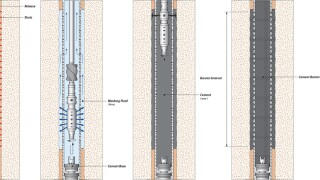Drilling
Oil and gas companies drilled 75 “high-impact” wells in 2024, representing 5.2 billion BOE.
This paper presents a comprehensive literature review of perforate, wash, and cement techniques that compares new methods with traditional ones and uses field cases and computational fluid dynamics to find the most cost- and time-effective practices without sacrificing safety.
The authors of this paper describe a method of stimulating a multizone hydrocarbon-producing well wherein a tool is deployed downhole by wireline to generate acid vapor at a target depth, allowing each interval to be treated uniquely.
-
This paper discusses the first multilateral well with a Level-4 junction combined with an inflow-control device (ICD) planned, designed, and drilled in the Upper Burgan reservoir of Raudhatain field, north Kuwait.
-
As with other MPD systems, SMD technology offers early detection of influxes (kicks) and minimizes downhole losses to weak subsurface formations.
-
Implementation of new technology can require that leadership and key team members be willing to step outside their comfort zones.
-
The work presented combines a fundamental-physics approach with field data to identify the root cause of drilling failures in Paleocene and Eocene injectite-sand intervals.
-
Large areas of the North Sea contain Cretaceous sediments, which form a massive hard layer of chalk that historically has presented a major drilling risk and expense to operators in the area.
-
Australian technology developer MezurX is touting its newly introduced flow, density, and mud monitoring system as a significantly better alternative to the widely used Coriolis meter.
-
On the basis of safety performance results achieved through automation downstream, an operator set out to achieve the same advances in its upstream business.
-
Seminole Services’ Powerscrew Liner System is a new expandable-liner hanger that is set with torsional energy from the topdrive.
-
With the innovation of extended-reach and directional drilling, running casing and liner strings has become increasingly difficult.
-
While rotary-steerable systems (RSSs) dominate the offshore directional-drilling markets, the land-based markets are still dominated by conventional directional-drilling tools. This paper presents a new RSS that is being designed and tested specifically for the onshore markets.













